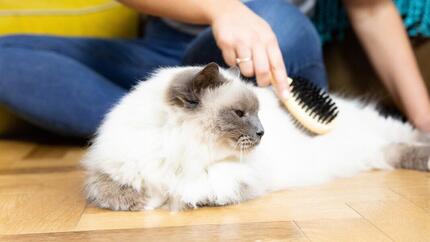
Your cat’s skin is a good general indicator of their health. It should be pink or black (depending on the breed) and their coat should be smooth and shiny.
Watch out for crusting, itching, scaling, black or white spots, bald patches and inflamed areas, as this is usually a sign that something’s not right. For example, small black dots could indicate fleas while a dull coat might suggest an underlying illness. Scratching and scabbing, meanwhile, could mean your cat has a skin disease. Pay attention to the skin around your cat’s ears, too. Any brownish discharge or redness should be investigated by your vet.
If you know what warning signs to look out for on your cat’s skin, you can help them get treatment as soon as you spot something that doesn’t seem quite right.
Dry skin in cats
Dry skin isn’t usually a serious health issue for cats, unless they’re continually scratching. The temperature of your home can affect their skin - dry skin can soon become itchy during winter when the heating is turned on. A humidifier might help your cat keep comfortable if this is a problem.
Common skin parasites
Common skin parasites on cats include fleas, ticks and mites. They can cause itchiness, inflammation and skin lesions, as well as hair loss. In some more serious cases, a heavy flea infestation can cause anaemia in kittens, which can be dangerous to their health. Fleas can also cause a specific allergy in cats known as flea allergy dermatitis (FAD - see below for more information). Most cat skin conditions involving parasites can be treated quickly, although some may require longer-term treatment.
Identifying cat fleas
Cats are very good at grooming themselves, so owners are sometimes surprised to learn that their cat has fleas! Many cat skin conditions can be caused by fleas, and the most obvious sign that the pesky parasites have taken up residence on your cat is persistent scratching, although some cats won’t scratch themselves but instead over-groom, sometimes leaving bald patches.
Cat fleas are dark brown and approximately 1-2mm long. You’ll usually notice them in your cat’s coat during combing (with a fine-toothed comb), along with tiny black specs of flea waste.
Treating fleas in cats
Talk to your vet if you suspect your cat has fleas – they’ll be able to recommend the most suitable treatment. Cat fleas are persistent little critters, so not only does your cat need to be treated but their environment must be treated, too. This means washing bedding, cushion covers and clothing at high temperatures. Once you’ve got rid of them, make sure you use a flea-prevention treatment all year round as both high humidity of the summer and central heating in winter make for cosy flea environments.
Cat fleas and flea allergy dermatitis (FAD)
Fleas can be very uncomfortable for your pet, and can cause pesky skin problems for cats. The most common flea found on cats is the cat flea, but rabbit and hedgehog fleas can also cause problems for your feline friend. Sometimes cats can become sensitive to flea saliva and develop an allergy to their bites, known as flea allergy dermatitis (FAD).
FAD can develop in different ways, although usually results in irritation and itchiness, which can lead to your cat scratching themselves, sometimes causing hair loss and small scabs on their skin (known as miliary dermatitis).
Cats with FAD have extremely sensitive skin, meaning that just one tiny flea could trigger a cycle of itching and scratching.
For more information on how to find out if your cat has fleas and treatment options, see our page on fleas and ticks for cats.
Feline skin allergies
Just like us, cats can develop an allergic reaction to all sorts of things. A reaction is caused by your cat’s immune system producing antibodies in response to the allergen, which ultimately cause inflammation, itchiness and other cat skin problems.
Common cat allergens include:
- Inhaled allergens including mould, pollen and house dust.
- Fleas.
- Contact dermatitis, which is caused by irritating substances coming in contact with your cat’s skin. These can include soaps and perfumes, household or garden sprays, chemicals, feathers, wool and even some flea collars.
- Certain types of food.
Hair loss (alopecia) in cats
Cats will shed hair all year round (known as moulting) but tend to lose more hair in the summer and autumn, so you may need to lend a hand to help them with their grooming– and invest in a good vacuum cleaner!
However if you notice that your cat is losing more hair than is normal during their moulting, they may be affected by alopecia (loss of fur). Cat hair loss is often down to over-grooming an itchy or sore area, perhaps due to cat skin infections such as ringworm (a fungal infection), common skin parasites such as fleas, ticks and mites, or hormonal problems. Over-grooming can also be down to behavioural problems or anxiety, which is usually more common in cats than it is dogs, and can result in your cat vomiting fur-balls due to the amount of fur they end up swallowing.
General poor health and nutrition are often the culprits behind cat skin complaints, although having a litter of kittens or an underlying disease can be to blame, too.
Treating alopecia in cats
Before your vet can suggest a treatment for your cat’s hair loss, they’ll need to look for the cause of the alopecia and other potential cat skin conditions. Fleas are a common cause of itchiness, which in turn can lead to hair loss, so your vet might recommend a flea treatment (which you should keep up-to-date with anyway).
Your vet might also take a sample of your cat’s fur or scrape a little sample of skin to test for ringworm and parasites, or they might take a blood sample to check for any underlying disease. Sometimes they’ll perform an allergy test, or a slightly larger cat skin sample will be taken, but under anaesthetic, so they won’t feel a thing.
If your vet can’t find the cause of the alopecia, or your cat isn’t responding to treatment, they may refer you to a veterinary dermatologist for a more in-depth investigation. If you or your vet thinks there’s a behavioural problem at play, then you’ll need to look for sources of stress in your cat’s lifestyle, or talk to an animal behaviourist.
Some cases of cat hair loss, such as ringworm, can be passed on to humans, although this is quite rare. Still, a visit to the vet is always a good idea to keep both you and your cat happy and healthy.
Summer care for your cat’s skin
Cats have sensitive ears and noses, which in summer can be susceptible to sunburn. Cats with white fur are particularly prone to sunburn, so protect them by applying a little smudge of sunscreen to exposed areas.
By following these tips and knowing how to keep your pet's skin in tip-top condition, you should have a very happy cat that you can cuddle with no worries.












